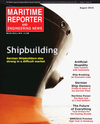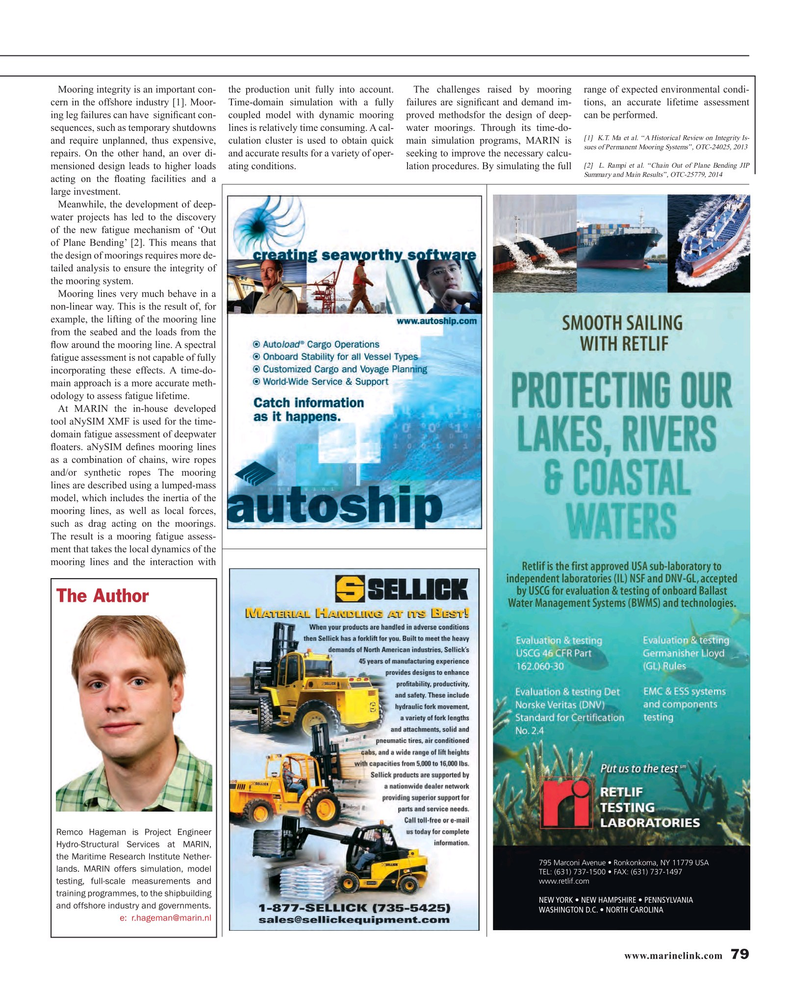
Page 79: of Maritime Reporter Magazine (August 2016)
The Shipyard Edition
Read this page in Pdf, Flash or Html5 edition of August 2016 Maritime Reporter Magazine
Mooring integrity is an important con- the production unit fully into account. The challenges raised by mooring range of expected environmental condi- cern in the offshore industry [1]. Moor- Time-domain simulation with a fully failures are signi? cant and demand im- tions, an accurate lifetime assessment ing leg failures can have signi? cant con- coupled model with dynamic mooring proved methodsfor the design of deep- can be performed.
sequences, such as temporary shutdowns lines is relatively time consuming. A cal- water moorings. Through its time-do- [1] K.T. Ma et al. “A Historical Review on Integrity Is- and require unplanned, thus expensive, culation cluster is used to obtain quick main simulation programs, MARIN is sues of Permanent Mooring Systems”, OTC-24025, 2013 repairs. On the other hand, an over di- and accurate results for a variety of oper- seeking to improve the necessary calcu- [2] L. Rampi et al. “Chain Out of Plane Bending JIP mensioned design leads to higher loads ating conditions. lation procedures. By simulating the full
Summary and Main Results”, OTC-25779, 2014 acting on the ? oating facilities and a large investment.
Meanwhile, the development of deep- water projects has led to the discovery of the new fatigue mechanism of ‘Out of Plane Bending’ [2]. This means that the design of moorings requires more de- tailed analysis to ensure the integrity of the mooring system.
Mooring lines very much behave in a non-linear way. This is the result of, for example, the lifting of the mooring line from the seabed and the loads from the ? ow around the mooring line. A spectral fatigue assessment is not capable of fully incorporating these effects. A time-do- main approach is a more accurate meth- odology to assess fatigue lifetime.
At MARIN the in-house developed tool aNySIM XMF is used for the time- domain fatigue assessment of deepwater ? oaters. aNySIM de? nes mooring lines as a combination of chains, wire ropes and/or synthetic ropes The mooring lines are described using a lumped-mass model, which includes the inertia of the mooring lines, as well as local forces, such as drag acting on the moorings.
The result is a mooring fatigue assess- ment that takes the local dynamics of the mooring lines and the interaction with
The Author
Remco Hageman is Project Engineer
Hydro-Structural Services at MARIN, the Maritime Research Institute Nether- 795 Marconi Avenue • Ronkonkoma, NY 11779 USA lands. MARIN offers simulation, model
TEL: (631) 737-1500 • FAX: (631) 737-1497 www.retlif.com testing, full-scale measurements and training programmes, to the shipbuilding
NEW YORK • NEW HAMPSHIRE • PENNSYLVANIA and offshore industry and governments.
WASHINGTON D.C. • NORTH CAROLINA e: [email protected] www.marinelink.com 79
MR #8 (74-81).indd 79 8/4/2016 4:34:04 PM

 78
78

 80
80
